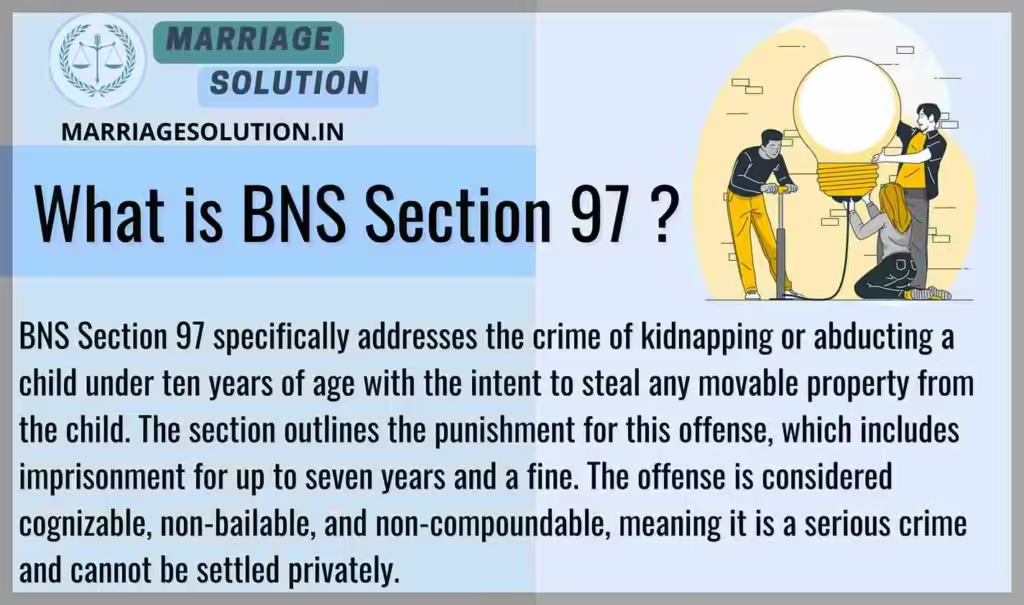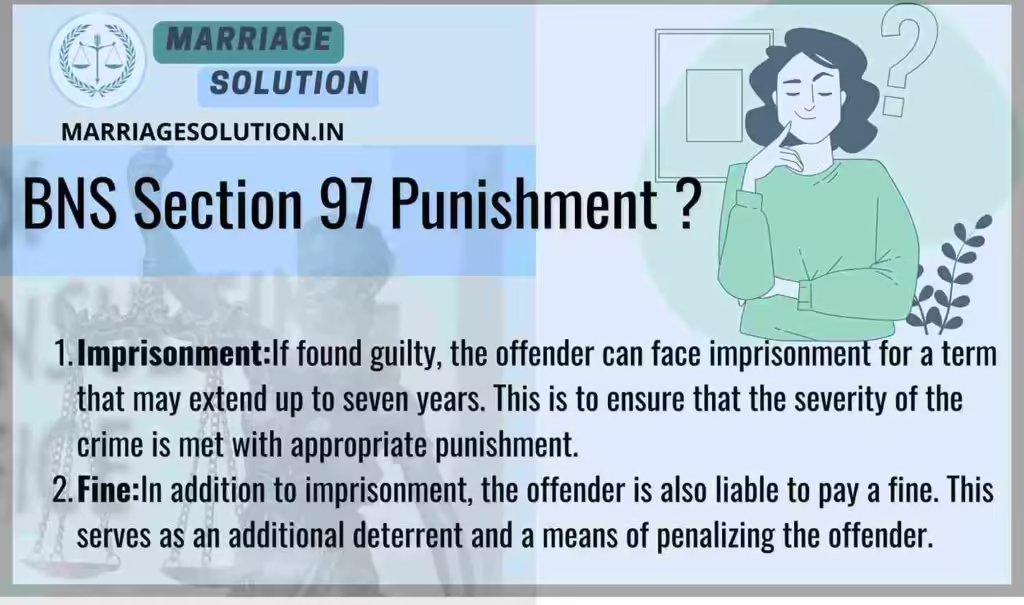Introduction of Section 97 BNS
BNS Section 97 , deals with kidnapping or abducting a child under the age of ten with the intention of stealing from them. The law recognizes that very young children are highly vulnerable and easy targets for criminals. By imposing imprisonment of up to seven years and fine, this section ensures strict punishment for offenders and reinforces the legal protection of children.
What is section 97 of BNS ?
BNS Section 97 specifically addresses the crime of kidnapping or abducting a child under ten years of age with the intent to steal any movable property from the child. The section outlines the punishment for this offense, which includes imprisonment for up to seven years and a fine. The offense is considered cognizable, non-bailable, and non-compoundable, meaning it is a serious crime and cannot be settled privately.

Section 97 BNS
Text of the Section:
“Whoever kidnaps or abducts any child under the age of ten years with the intention of taking dishonestly any movable property from the person of such child, shall be punished with imprisonment which may extend to seven years, and shall also be liable to fine.”
Who can be punished?
Any person—man, woman, or stranger—who kidnaps or abducts a child below 10 years with the intent to steal movable property from the child (such as jewelry, cash, or toys).
Key Element – Kidnapping or Abduction for Theft
The crime is not just about kidnapping. The intention must be to steal property from the child. Without this intent, Section 97 does not apply.
Age Limit
This section specifically protects children under 10 years because they are especially vulnerable and unable to protect themselves.
Movable Property
The theft must relate to property that the child is carrying or wearing—like money, ornaments, or belongings.
Punishment
- Imprisonment up to 7 years
- Fine, in addition to imprisonment
This ensures a strict penalty for those who target children for theft.
Why this law is important
Children under 10 are easy targets for criminals. By making this offense cognizable, non-bailable, and non-compoundable, the law ensures that offenders are punished and children are legally safeguarded.
Legal Nature of the Offense
- Cognizable: Police can arrest without a warrant.
- Non-bailable: Bail is not a right; court decides.
- Non-compoundable: The case cannot be settled privately.
- Triable by: Magistrate of the First Class.
Illustrations (Examples)
Example 3 (Not an Offense): A relative takes a child under 10 without permission but without any intention of theft. This may fall under kidnapping provisions, but not Section 97.
Example 1 (Offense): A man abducts a 9-year-old wearing a gold chain with the intent to steal it. He is guilty under Section 97.
Example 2 (Offense): A woman kidnaps an 8-year-old boy carrying money to buy groceries. Her intent to steal makes it punishable.
Section 97 BNS Overview
BNS Section 97 punishes anyone who kidnaps or abducts a child under ten years of age with the intention of stealing any movable property from the child. The offense is punishable with imprisonment, which can extend to seven years, and the offender is also liable to a fine.
BNS Section 97 : 10 Key Point
1. Protects Children Under 10
This law is made especially for the safety of children below 10 years of age. At such a young age, children are completely dependent on adults and cannot defend themselves from kidnappers or thieves. That is why the law treats any crime against such children as very serious.
2. Kidnapping + Theft Intent
For Section 97 to apply, two conditions must happen together: (a) the child is kidnapped or abducted, and (b) the criminal’s main purpose is to steal property from the child. For example, if someone kidnaps an 8-year-old girl only to steal her gold earrings, both kidnapping and theft intentions are present.
3. Movable Property
The theft must relate to things the child is carrying or wearing, like jewelry, toys, mobile phones, or cash. The law covers only movable property (things that can be taken away), not land or houses. This ensures that even small belongings of the child are legally protected.
4. Imprisonment
The punishment can be up to 7 years in jail, which shows how seriously the law views such crimes. Exploiting small children for theft is not seen as a minor wrongdoing but a grave criminal act that deserves strict punishment.
5. Fine
Apart from imprisonment, the offender may also be ordered to pay a fine. This adds financial punishment to the jail term. For example, if the stolen item was valuable, the court may impose a heavy fine in addition to prison time.
6. Cognizable Offense
The offense is cognizable, which means the police can arrest the criminal without waiting for a court warrant. This is important because in cases involving children, quick action is needed to rescue the child and prevent further harm.
7. Non-Bailable
The offense is non-bailable, which means the accused cannot automatically get bail. Only the court has the power to grant bail after careful consideration. This rule prevents criminals from escaping easily and ensures the case is handled seriously.
8. Non-Compoundable
This crime is non-compoundable, which means it cannot be settled privately between the offender and the victim’s family. A proper trial in court is mandatory. This prevents rich or powerful offenders from paying money to escape punishment.
9. Trial by Magistrate
Cases under Section 97 are handled by a Magistrate of the First Class, who has the authority to give punishments of up to 7 years imprisonment. This ensures that the case is dealt with by a competent judicial officer who can deliver fair justice.
10. Long-term Impact
If convicted, the offender will have a criminal record that stays for life. This record brings social shame, and the person may face difficulties like getting government jobs, passports, or licenses. This long-term impact acts as an extra deterrent against committing such crimes.
BNS 97 Punishment
The punishment under Section 97 BNS is imprisonment for up to seven years and a fine. The offense is treated seriously as it combines kidnapping with theft against vulnerable children.

BNS 97 bailable or not ?
BNS Section 97 is non-bailable. This means that the accused cannot be released on bail as a matter of right. The severity of the crime ensures that the accused remains in custody while awaiting trial.
Comparison: BNS Section 69 vs IPC Section 369
| Section | Offense | Punishment | Cognizable? | Bailable? | By What Court Triable |
|---|---|---|---|---|---|
| BNS Section 69 | Kidnapping or abducting a child under ten years of age with the intent to steal from the person of such child, or to subject the child to grievous harm. | Imprisonment up to 7 years, and fine. | Cognizable | Bailable | Magistrate of the First Class |
| IPC Section 369 (Old) | Kidnapping or abducting a child under ten years of age with intent to steal from the person of such child, or to cause the child to be exposed to grievous harm. | Imprisonment up to 7 years, and fine (same as BNS). | Cognizable | Bailable | Magistrate of the First Class |
The Bharatiya Nyaya Sanhita (BNS) Section 97 replaces the old Indian Penal Code (IPC) Section 369.
BNS Section 97 FAQs
What does BNS Section 97 address?
It deals with kidnapping or abducting a child under ten years of age with the intent to steal movable property from them.
What is the age limit mentioned in BNS Section 97?
The section applies to children under ten years of age.
BNS Section 97 Bailable Who conducts the trial under BNS Section 97?
The trial for cases under BNS Section 97 is conducted by a Magistrate of the First Class. This is the judicial authority responsible for hearing and deciding on such cases.
Conclusion
Section 97 BNS provides vital protection to children under 10 years by criminalizing kidnapping for theft. By making it a cognizable, non-bailable, and non-compoundable offense with up to seven years of imprisonment, the law emphasizes the seriousness of exploiting minors and ensures that offenders face strict legal consequences.”
Need Legal Support?
If you’re facing court proceedings, marriage-related issues, or any legal matter, our team at Marriage Solution – Lawyer Help is ready to guide you. Just complete our easy online enquiry form, and we’ll connect you with the right legal assistance tailored to your needs.
Finished with BNS 97 ? Continue exploring the next provisions of the Bharatiya Nyaya Sanhita (BNS), 2023. Each section includes explanations, examples, and plain-language breakdowns for easy understanding.
- Section 98 BNS : Selling child for purposes of prostitution, etc .
- https://marriagesolution.in/bns_section/section-98-bns/
- Section 99 BNS : Buying child for purposes of prostitution, etc .
- https://marriagesolution.in/bns_section/section-99-bns/
- BNS 100 : Culpable homicide .
- https://marriagesolution.in/bns_section/bns-100/
- BNS 101: Murder .
- https://marriagesolution.in/bns_section/bns-101/
- BNS 102 : Culpable homicide by causing death of person other than person whose death was intended.
- https://marriagesolution.in/bns_section/bns-102/
Full IPC Section List: https://marriagesolution.in/ipc-section-list
All Indian Law & Blogs: https://marriagesolution.in/indian-law/
Full BNSS Section List: https://marriagesolution.in/bnss_section-list
